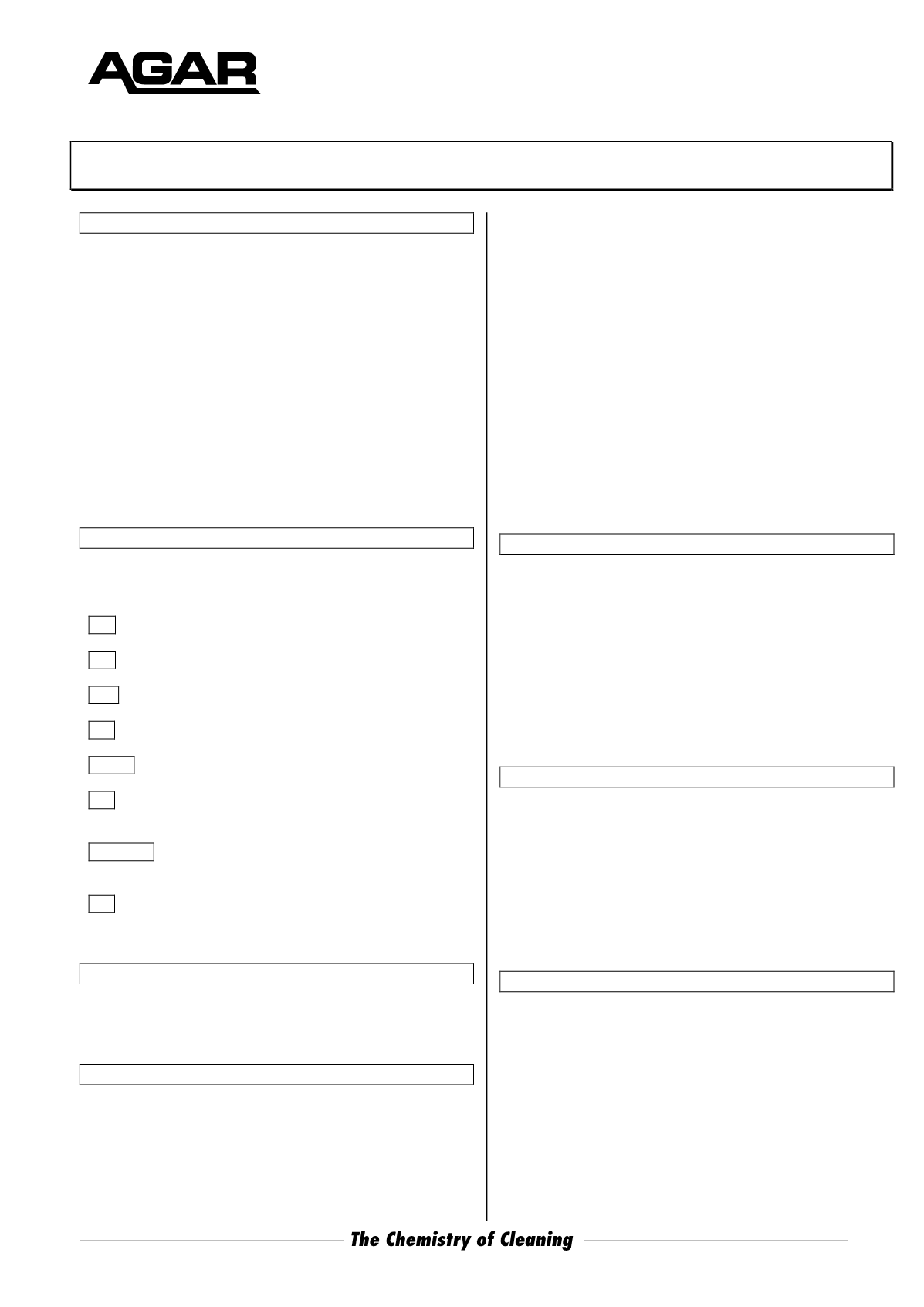

ABN 80 004 726 890
MADE IN AUSTRALIA
VIC 03 9480 3000
NSW 02 9743 6020
SA 08 8293 2020
QLD 07 3205 7244
WA 08 9249 4566
Safety Data Sheet
Issued: April 14, 2011
Page 1 of 3
CAUSTIC SODA
1 IDENTIFICATION OF THE MATERIAL AND SUPPLIER
Product Name:
CAUSTIC SODA
Other Names: Sodium hydroxide, Soda lye, Sodium hydrate,
White caustic, Caustic soda solid, Caustic soda
pearl, Solid caustic soda.
Manufacturer's Product Code: CAU5, CAU20
Product Use: For removing fats from hard surfaces.
COMPANY DETAILS
Company: Agar Cleaning Systems Pty. Ltd.
Address: 12-14 Cope Street, Preston, Vic. 3072
Telephone: 03 9480 3000 Facsimile: 03 9480 5100
Web:
www.agar.com.auAgar SDS are available from this website.
E-mail:
admin@agar.com.auEmergency Telephone Number: 131 126
(Aust wide)
2 HAZARDS IDENTIFICATION
Hazardous according to criteria of Safe Work Australia.
Corrosive C
R35 Causes severe burns.
R41 Risk of serious damage to eyes.
S1/2 Keep locked up and out of the reach of children.
S22 Do not breathe dust.
S24/25 Avoid contact with skin and eyes.
S26 In case of contact with eyes, rinse immediately
with plenty of water and seek medical advice.
S36/37/39 Wear suitable protective clothing, gloves and
eye/face protection.
S45 In case of accident or if you feel unwell, seek
medical advice immediately (show the label
whenever possible).
3 COMPOSITION / INFORMATION ON INGREDIENTS
Ingredients:
Chemical Entity:
CAS No.:
Proportion:
Sodium hydroxide
1310-73-2
> = 98%
4 FIRST AID MEASURES
Poisons Information Centre: Phone 131 126
Swallowed: Immediately rinse mouth with water. If swallowed,
do NOT induce vomiting. Give a glass of water. Seek
immediate medical assistance.
Eye: If in eyes, hold eyelids apart and flush the eye continuously
with running water. Continue flushing until advised to stop by
the Poisons Information Centre or a doctor, or for at least 15
minutes.
Skin: If spilt on large areas of skin or hair, immediately drench
with running water and remove clothing. Continue to wash
skin and hair with plenty of water (and soap if material is
insoluble) until advised to stop by the Poisons Information
Centre or a doctor. For skin burns, cover with a clean, dry
dressing until medical help is available.
Inhalation: Remove victim from area of exposure – avoid
becoming a casualty. Remove contaminated clothing and
loosen remaining clothing. Allow patient to assume most
comfortable position and keep warm. Keep at rest until fully
recovered. If patient finds breathing difficult and develops a
bluish discolouration of the skin (which suggests a lack of
oxygen in the blood – cyanosis), ensure airways are clear of
any obstruction and have a qualified person give oxygen
through a face mask. Apply artificial respiration if patient is not
breathing. Seek immediate medical advice.
Advice to doctor: Treat symptomatically. Can cause corneal
burns.
5 FIRE FIGHTING MEASURES
Fire/Explosion Hazard: Caustic Soda is a non-combustible
material.
Fire Extinguishing media: If material is involved in a fire use:
Water fog (or if unavailable fine water spray), foam, dry agent
(carbon dioxide, dry chemical powder).
Fire Fighting PPE: Decomposes on heating emitting toxic
fumes. Fire fighters to wear self-contained breathing
apparatus and suitable protective clothing if risk of exposure to
products of decomposition.
Special fire-fighting procedures: None.
Unusual fire hazards: None
6 ACCIDENTAL RELEASE MEASURES
Clear area of all unprotected personnel. Wear protective
equipment to prevent skin and eye contact and breathing in
dust. Work up wind or increase ventilation. Cover with damp
absorbent (insert material, sand or soil). Sweep or vacuum up,
but avoid generating dust. Collect and seal in properly labelled
containers or drums for disposal.
Caution – heat may be evolved on contact with water. If
contamination of sewers or waterways has occurred advise
local emergency services.
7 HANDLING AND STORAGE
Handling: Avoid skin and eye contact and breathing in dust.
Storage : Store in a cool, dry, well ventilated place and out of
direct sunlight. Store away from incompatible materials
described in Section 10. Keep containers closed when not in
use – check regularly for spills.
This material is a Schedule Poison S6 and must be stored,
maintained and used in accordance with the relevant
regulations.
Please turn to page 2.


















